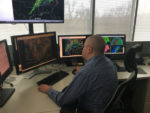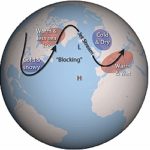The United States is making exciting changes to how computer models will be developed in the future to support the nation’s weather and climate forecast system. NOAA and the National Center for Atmospheric Research (NCAR) have joined forces to help the nation’s weather and climate modeling scientists achieve mutual benefits through more strategic collaboration, shared resources and information.
NOAA Report: Effects of Persistent Arctic Warming Continue to Mount
NOAA is out with their 2018 Arctic Report Card and the news is not good, folks. Issued annually since 2006, the Arctic Report Card is a timely and peer-reviewed source for clear, reliable and concise environmental information on the current state of different components of the Arctic environmental system relative to historical records. “The Report Card is intended for a wide audience, including scientists, teachers, students, decision-makers and the general public interested in the Arctic environment and science.”
NOAA Looks to Dell for Massive Supercomputing Upgrade
Today NOAA announced to plans for a major upgrade to its supercomputing capabilities. The upgrade adds 2.8 petaflops of computational power, enabling NOAA’s National Weather Service to implement the next generation Global Forecast System, known as the “American Model,” next year. “Having more computing speed and capacity positions us to collect and process even more data from our newest satellites — GOES-East, NOAA-20 and GOES-S — to meet the growing information and decision-support needs of our emergency management partners, the weather industry and the public.”
Engility To Provide NOAA With HPC Expertise
Today Engility announced $14 million in task order awards from NOAA’s Geophysical Fluid Dynamics Laboratory. Engility scientists will conduct HPC software development and optimization, help users gain scientific insights, and maintain cyber security controls on NOAA’s R&D High Performance Computing System. These services assist NOAA GFDL in enhancing and advancing their HPC capability to explore and understand climate and weather. “As we saw with Hurricanes Harvey and Irma, a deeper understanding of climate and weather are critical to America’s preparedness, infrastructure and security stance,” said Lynn Dugle, CEO of Engility. “Engility has been at the forefront of leveraging HPC to advance scientific discovery and solve the toughest engineering problems. HPC is, and will continue to be, an area of high interest and value among our customers as they seek to analyze huge and ever-expanding data sets.”
Top Weather and Climate Sites run on DDN Storage
“DDN’s unique ability to handle tough application I/O profiles at speed and scale gives weather and climate organizations the infrastructure they need for rapid, high-fidelity modeling,” said Laura Shepard, senior director of product marketing, DDN. “These capabilities are essential to DDN’s growing base of weather and climate organizations, which are at the forefront of scientific research and advancements – from whole climate atmospheric and oceanic modeling to hurricane and severe weather emergency preparedness to the use of revolutionary, new, high-resolution satellite imagery in weather forecasting.”
UK Met Office Research Simulations Predict European Winter One Year Ahead
In a paper published today in Nature Geoscience, scientists at the Met Office have demonstrated significant advances in predicting up to one year ahead the phases of the North Atlantic Oscillation (NAO), which drives European and North American winter variability. The NAO – a large-scale gradient in air pressure measured between low pressure around Iceland and high pressure around the Azores – is the primary driver of winter climate variability for Europe.
Supercomputers Power NOAA Flood Forecasting Tool
NOAA and its partners have developed a new forecasting tool to simulate how water moves throughout the nation’s rivers and streams, paving the way for the biggest improvement in flood forecasting the country has ever seen. Launched today and run on NOAA’s powerful new Cray XC40 supercomputer, the National Water Model uses data from more than 8,000 U.S. Geological Survey gauges to simulate conditions for 2.7 million locations in the contiguous United States. The model generates hourly forecasts for the entire river network. Previously, NOAA was only able to forecast streamflow for 4,000 locations every few hours.
Video: A NASA Perspective on El Niño
In this video, Steven Pawson discussed how NASA uses computer models to build up a complete three-dimensional picture of El Niño in the ocean and atmosphere. Pawson is an atmospheric scientist and the chief of the Global Modeling and Assimilation Office at NASA’s Goddard Space Flight Center in Greenbelt, Maryland.
NOAA Upgrades Supercomputers to 5.78 Petaflops
Today NOAA reported a nearly four-fold increase in computing capacity to innovate U.S. forecasting in 2016. NOAA’s Weather and Climate Operational Supercomputer System is now running at record speed, with the capacity to process and analyze earth observations at quadrillions of calculations per second to support weather, water and climate forecast models. This investment to advance the field of meteorology and improve global forecasts secures the U.S. reputation as a world leader in atmospheric and water prediction sciences and services.
Video: NOAA Software Engineering for Novel Architectures (SENA) Project
“NOAA will acquire software engineering support and associated tools to re-architect NOAA’s applications to run efficiently on next generation fine-grain HPC architectures. From a recent procurement document: “Finegrain architecture (FGA) is defined as: a processing unit that supports more than 60 concurrent threads in hardware (e.g. GPU or a large core-count device).”











